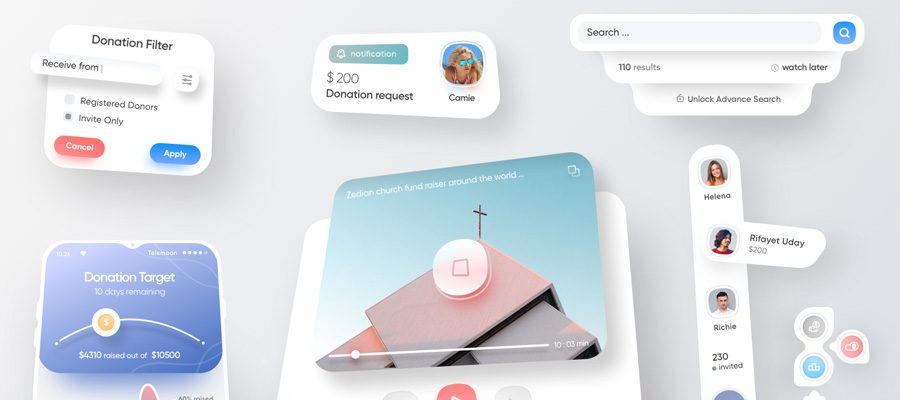If you want to take your business to the next level, then it’s important that you have a mobile-friendly website as we go into 2021. This won’t be the first time that you’ve heard the importance of a mobile friendly website design, but it’s becoming increasingly essential. With a new Google update on its way soon, it’s becoming more likely that one of the benefits of mobile-friendly website will be a boost in search engine ranking position. On this page, you’ll be able to learn more about mobile friendly pages, including what good mobile design looks like and why a mobile-friendly website is important for SEO.

design by Cuneyt SEN
So, without further introduction, let’s dive into the topic and learn all about why mobile friendly websites are important.
Why mobile-friendly websites are important?
To get a sense of why the importance of mobile web design has developed, we need to take a look at the history of mobile usage, and why it’s more important to have mobile-friendly content than ever before. Whereas people used to be all the emphasis on the importance of website design, today it’s also about mobile, for the simple fact that many people than ever before are choosing to browse the web on their smartphone, rather than on their desktop computer.
How much has mobile grown to date?
If you want to reach as large an audience as possible, then you need to go to where the people are. Or, more specifically, how people are getting to where they want to be. Online, that is increasingly meaning via their smartphone. Let’s take a look at the increase of mobile usage in recent times. In 2015, the percentage of internet traffic that came through smartphones was around 30%. By the third quarter of 2020, it was more than 50%. That means more internet requests are made through a smartphone than a desktop.
How many websites are not mobile friendly?
Given the importance of having a mobile-friendly website, and the fact that companies have been told for years of its importance, then you’d think that the majority of websites would be suitable for smartphones. But that’s not the case. A recent study of the top one million sites on the internet found that only around 25% of them were friendly for mobiles. So the mobile friendly website statistics shows that the message has not gotten through. The study also found that the sites that were not mobile friendly scored poorly by Google’s rankings.
What are mobile-friendly websites?
If you want to make your website friendly for smartphone users, then you’ll need to know what mobile-friendly websites are. This is when the regular website that you see on desktop devices is shrunk down to fit the mobile size screen. It looks like your website, just smaller. Depending on the quality of the website design, it can be a good or not so good user experience. In most cases, the functionality of things like header section, content section, navbar Section, footer section, page section, home button, back button, and so on will have been removed or at least reduced, to optimise performance.
What is the difference between mobile-friendly and mobile responsive?
There are some subtle but important differences between mobile-friendly and mobile responsive designs. A mobile-friendly site is one that’ll look good on the mobile, but which is essentially the same as the one that you’d see on a desktop. What’s changed is the scale of the website, not the website itself. Mobile friendly design is one that has the mobile at the core of its design. That way, the look and feel of the site have been optimised for the user. Rather than building backwards (trying to make a desktop computer website fit onto a smartphone), you build up, putting all the pieces of the mobile design into place first and then thinking about the desktop design. A responsive design is one that responds to the device that the website is being accessed on.
First things first, establish what your clients use. Do your clients use mobiles?

Sketch on Black by Bal Sieber
It’s generally a good idea to have a mobile friendly website no matter what business you’re running, but for some businesses, it’ll be even more important. So, take a look at your client's: do they use smartphones? If they’re in the 18 - 35 bracket, then the answer is yes, a lot. If they’re in the 50 - 74 bracket, the answer will be “less so.” You can take a look at Google analytics to find out about your visitors, including how they access your website.
How having a mobile-friendly site affects SEO?
Having a mobile-friendly site won’t just improve the user experience, it’ll also give your SEO a nudge in the right direction too. Google SEO mobile-friendly sites, and you’ll find that they’re above the ones that aren’t mobile-friendly. If you can incorporate AMP into your website, then you’ll find that you get even more visitors, because this content loads extremely quickly.
In all, you’ll find that your website is ranked higher by Google if you have a site that mobile users can use. Google is increasingly focused on the user experience, which means mobile-friendly sites.
If you’re going to develop a mobile site, then it’s really important to keep the website speed in mind. People don’t like to wait around for their sites to load at the best of times, but there’s something else to consider here -- on desktops, people are connected to their home WIFI. They don’t need to think about how much data is being used, and also, they nearly always have fast speeds. When they’re on a smartphone, they’ll often be using data. This is slower, so your website needs to load quickly. There’s also the matter of their data usage -- people won’t stick around on a website if they think that it’s consuming all of their data. So, make sure that there are no data intensive features on your website that could cause people to click ‘x’ on your website.
It’s all about user experience.
The reason why so many businesses are eager to put mobile-friendly website design into practice is that it boosts the user experience. And in this day and age, that’s key. Rather than having a mobile user browse a deformed version of your desktop computer, you can give them the full experience. The website will load faster (deeply important to today’s internet users) and the usability will be improved. So, take a look at your site on a smartphone. Does the content look good, is the text size right? Do the images you’re hosting resize for mobile, or are they turned off altogether? You’ll need to give additional consideration if you want to host video on your mobile version.
Does it improve conversion rates?
Of course, you’re not going to go through all of the trouble of creating a mobile-friendly website if it doesn’t have a positive impact on your bottom line. You’ll want to see an increase in your conversion rate. But this seems like something that would happen, or perhaps we’d find that your conversion rate would dip if you don’t. There’s a more direct impact on sales, too. For example, it helps to get more sales. How? By making it easy for people to check out and make their purchase through their device. Shopping cart abandonment is a problem, and you don’t want to give another reason for potential customers to walk away when they’re on the hook. It’ll also allow you to keep a consistency regarding your branding. Ultimately, any serious and well-run small business or large business will have a good mobile site.

concept by MonpixDesign
How do you make it mobile friendly?
There are many things you can do to make your website mobile friendly. It’s all about keeping the user and the device in mind. For example, while on a desktop computer you would hover and click, on a smartphone you would tap. Both of these functions will take you to the same place (the page you want to visit), but how you get there will be different. Because space is limited, you’ll also see things like collapsible containers. This is where the contents of a dropdown menu (or even the presence of the menu) is hidden until clicked, because they would otherwise take up too much space. Perhaps the best method when it comes to making a mobile friendly site is to remember that a phone is not equal to a desktop, and a desktop is not a tablet.
Make Your Website Future Proof
Ultimately, in this day and age, businesses are running a risk if they do not don’t have a mobile friendly website. With more and more people searching for businesses online before becoming a customer, and many of those searches being made through a smartphone device, it’s one of the simplest ways to make sure that your company is ready for the future. The percentage of internet traffic that was mobile - more than 50% - that we mentioned earlier is only likely to increase in the coming years.




















